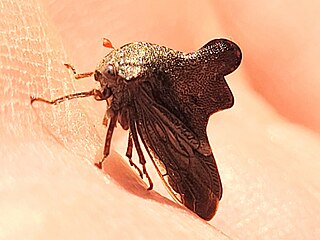
Treehoppers and thorn bugs are members of the family Membracidae, a group of insects related to the cicadas and the leafhoppers. About 3,200 species of treehoppers in over 400 genera are known. They are found on all continents except Antarctica; only five species are known from Europe. Individual treehoppers usually live for only a few months.

The buffalo treehopper is a species of treehopper belonging to the subfamily Smiliinae. It is sometimes classified as Ceresa bisonia.

Stictocephala is a genus of treehoppers in the family Membracidae; in the subfamily Smiliinae and tribe Ceresini. Species appear to be distributed mostly in North America, but S. bisonia has become widely distributed in Europe.

Centrotus cornutus (thorn-hopper) is a species of "treehoppers" belonging to the family Membracidae.

Enchenopa binotata is a complex of multiple species found mostly in Eastern North America, but have also been reported in Central America. They are commonly referred to as treehoppers and are sap-feeding insects. The species in the complex look similar to each other in morphology, but are identified as different species by the host plant they occupy.

Entylia carinata, commonly known as the keeled treehopper, is a species of treehopper in the family Membracidae. They can be found in Brazil, Panama, Mexico, the United States, and Canada. Keeled treehoppers are often attended by ants which feed on the honeydew they excrete. In return, the ants offer protection from predators. Keeled treehoppers typically feed on plants in the aster family and they are not known to transmit plant diseases and are not considered significant plant pests.

Microcentrus caryae, the hickory stegaspidine treehopper, is a species of treehopper in the family Membracidae.

Thelia is a genus of treehoppers in the family Membracidae. There are at least two described species in Thelia.

The Brazilian treehopper is a species of insect belonging to the treehopper family (Membracidae). It has unusual appendages on its thorax. While Bocydium can be found throughout the world, they are most prevalent in Africa, North and South America, Asia and Australia. They exhibit limited movement and their primary food source is from the underside of leaves. They also exhibit hemimetabolous development. Treehoppers range from about two millimeters to two centimeters in length.

Hebetica sylviae is a member of the treehopper family Membracidae. It is found in the eastern United States, first discovered in Murray, Kentucky, with a second sighting in Atlanta, Georgia.
Telamona tiliae, also known as the basswood treehopper, is a species of treehopper in the family Membracidae. It was first described by Elmer Darwin Ball in 1925.
Telamona concava is a species of treehopper in the family Membracidae. It was first described by Asa Fitch in 1851.
Telamona lugubris is a species of treehopper in the family Membracidae.
Telamona molaris is a species of treehopper in the family Membracidae.

Archasia belfragei is a species of treehopper in the family Membracidae.
Heliria gemma is a species of treehopper in the family Membracidae.

Heliria praealta is a species of treehopper in the family Membracidae. It is found in the western United States and Canada.

Carynota mera is a species of treehopper. It belongs to the genus Carynota in the family Membracidae. It was first described by Thomas Say in 1830 as Membracis mera.
Cyrtolobus fenestratus is a species of treehopper belonging to the family Membracidae. It was first described by Dr. Asa Fitch in 1851.
Smilia fasciata is a species of treehopper belonging to the family Membracidae. It was first described by Charles Jean-Baptiste Amyot and Jean Guillaume Audinet-Serville in 1843.













